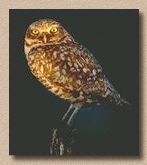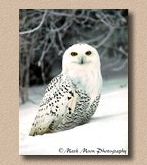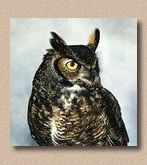
Barn Owl
Also known as the "ghost" owl or "spirit" owl. The Barn Owl is different from most owls. It has unusually long legs and long talons, and has small, dark colored eyes. They do not like daylight at all, so you won't catch a peek of this owl until it's really dark! Barn Owls probably have the best hearing of any owl, and experiments have shown that they can hunt their prey by sound alone. Barn Owls hunt from a perch. They listen as their prey moves below them and then they swoop down and grab it with their talons. They like to roost and nest in old buildings, barns and silos.

Burrowing Owl
The Burrowing Owl makes its home, of course, in a burrow. It is one of the owls that is diurnal (active during the night and day). The Burrowing Owl searches for its prey from atop its burrow mound or by hovering above the ground. It feeds on insects, small mammals, birds, lizards and small fish. It also has a habit of collecting odds and ends and then laying them out around the entrance to its burrow. Weasels, ferrets, snakes and skunks are enemies of the Burrowing Owls and will go after the young owls as food. Burrowing Owls will imitate a rattlesnake's buzz to try to keep enemies away.

Snowy Owl
This owl lives in the Arctic areas of North America. It has adapted to the long summer days and long winter nights of its home, and can hunt well at any time of the day. The Snowy Owl is almost all white with scattered dark spots. Its bill is black, its head rounded, and its legs heavily feathered. The Snowy Owl likes to eat hares, small rodents, ducks and geese.

Great Horned Owl
The Great Horned Owl gets its name from the large tufts of feathers on its head; they are neither ears or horns, just feathers. It is the largest owl in North America and is sometimes called the "cat owl." The Great Horned Owl is nocturnal and likes to eat rabbits, skunks, mice, squirrels, birds and fish.